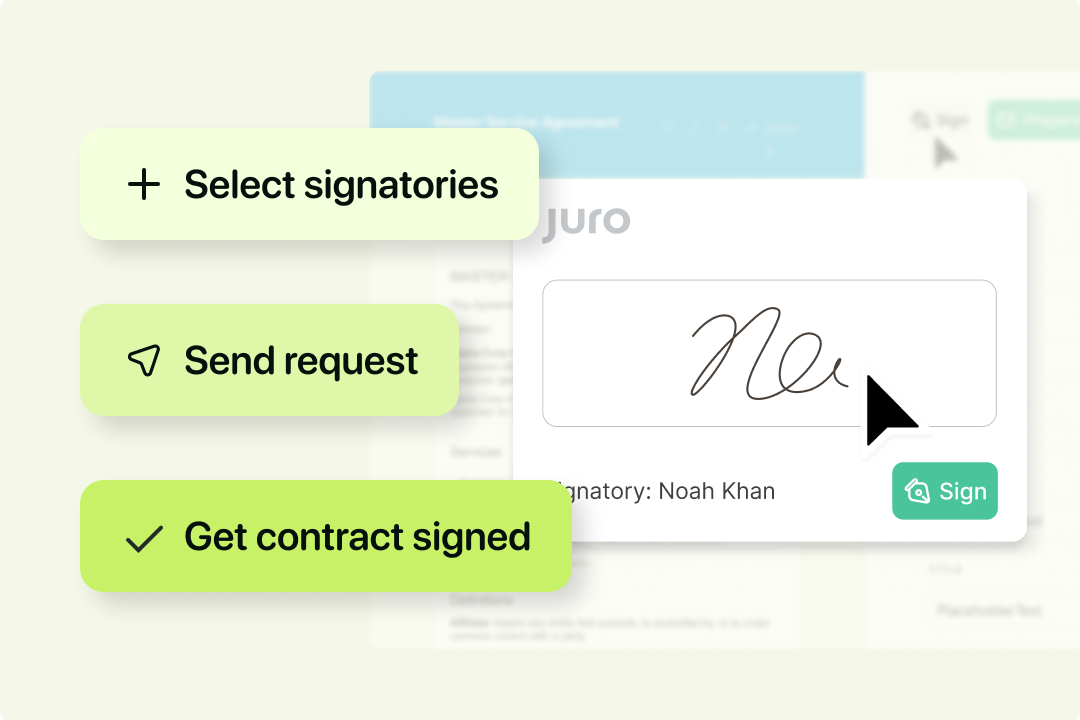Solutions
Customer Support
Resources
Confused about whether to sign a document in digital or electronic form? You've come to the right place. This guide covers the differences between digital and electronic signatures in more detail and why businesses often need both during the signing process.
An electronic signature is a digital markup added to a contract to show that the parties have agreed to the contract’s terms. Electronic signatures replace wet ink signatures, which are added to physical copies of a contract.
Rather than having to physically add an impression, mark, or name to a paper contract using a pen, electronic signatures enable legal and business teams to create these signatures online instead. These electronic signatures demonstrate a party’s willingness to agree certain contract terms, and so are legally binding as a result.
Electronic signatures can be created in lots of ways, and you can find guides to each approach below:
The best and most efficient way to create an electronic signature is by using electronic signature software, like DocuSign, which helps businesses effortlessly manage electronic and digital signatures. However, there are plenty of alternatives to DocuSign that might suit your business better in terms of budget and functionality.

A digital signature is a method used to ‘seal a document' and provide evidence of the document's integrity and authenticity. It isn't a signature in the legal sense, but rather a safeguard against tampering and forgery when managing different legal documents.
Confusingly, a digital signature doesn't look like a handwritten signature at all. Instead, it is a digital record that helps businesses and authorities to identify documents and protect them from being tampered with, forged, or replicated in some way.
This helps to ensure that the person signing a contract is who they claim to be and that the signature hasn't been interfered with in any way.
Unlike electronic signatures which use more basic authentication methods to verify signer identities, like phone PINs and email addresses, digital signatures rely on more advanced authentication processes, like certificate-based IDs.
Juro's native eSignature functionality achieves this same level of security by using strict identity verification processes, like collecting IP addresses, creating timestamps, and creating a detailed audit trail for all contracts created and signed in the platform.
This means that Juro users benefit from the legal validity of both electronic signatures and the advanced security features of digital signatures - all with one tool. To find out more about Juro's advanced electronic signature functionality and stringent security measures, hit the button below.
The terms "digital signature" and "electronic signature" are often used interchangeably, but they serve different purposes. Both add authenticity and integrity to documents, yet they achieve this in distinct ways:
For example, Juro's eSignature feature lets legal and business teams sign contracts electronically from any device. At the same time, Juro’s digital signature properties ensure that these contracts remain secure and unaltered.
While they are not the same, digital and electronic signatures often work in tandem to make documents both legally binding and secure.
This means that although they are not the same, digital signature technology can be used alongside electronic signatures to make a signed document more secure.
There are a few key distinctions that set digital signatures an electronic signatures apart. Let's run through these now.
The biggest distinction lies in what each type of signature is designed to achieve:
Together, these features protect the document’s integrity and ensure its legal enforceability.
Whilst electronic signatures can be created by contract parties in Word or PDF, or even using Juro’s native eSignature feature, digital signatures are not created by people.
Electronic signatures are created and added to contracts by individuals and teams signing or marking the document in some way.
Meanwhile, digital signatures are generated by software and rely on cryptographic methods like Public Key Infrastructure (PKI). PKI creates a unique public and private key pair to secure the document and verify its authenticity.
Since digital signatures rely on strict security mechanisms and processes, it is often more challenging to deliver a digital signature than it is an electronic signature.
This is because there’s often no validation process for standalone electronic signatures, whereas when a digital signature is added to a document, the user’s identity is verified and cryptography is used to bind the digital certificate.
.png)
Fortunately, legal and business teams can benefit from the security of digital signatures and the legal validity of electronic signatures with ease using Juro.
Juro’s native eSignature feature enables users to sign contracts quickly and easily, with the platform creating an immutable document record and an audit trail of key actions on their behalf. This makes getting contracts over the line seamless, without compromising on security.
The idea behind digital signatures is that they are not susceptible to tampering or being altered, which makes them more secure as a result.
Digital signatures often provide a detailed audit trail which enables parties to identify if and when specific changes have been made to a document, as well as when it’s been signed and by who.
Unlike digital signatures which use cryptographic encryption methods, electronic signatures don’t necessarily need to meet the same stringent requirements as digital signatures.
Since the purposes of digital signatures and electronic signatures differ, they are often used in different ways and contexts too.
Electronic signatures are most commonly used in business contexts where speed, convenience, and legal compliance are crucial. These signatures are added to various types of business contracts, such as sales contracts, non-disclosure agreements (NDAs), lease agreements, and employment contracts.
For example, a sales team might use electronic signatures to quickly finalize agreements with clients. Instead of waiting for a physical signature, electronic signatures allow contracts to be signed, sealed, and delivered within minutes—streamlining the sales process and reducing delays in closing deals.
{{quote1}}
Similarly, HR departments frequently use electronic signatures to onboard new employees. Job offers, tax forms, and employment agreements can be signed remotely, making the process more efficient and convenient for both parties.
Electronic signatures are also widely used in international transactions. They enable businesses operating across borders to finalize agreements without the logistical challenges of couriering documents for wet ink signatures.
Digital signatures, on the other hand, are often used in contexts that prioritize security and document integrity. Certification authorities (CAs) and trust service providers (TSPs) play a central role in issuing and validating digital signatures.
These entities ensure that a document’s authenticity is beyond dispute, using cryptographic methods to verify the signer's identity.
For instance, government agencies often rely on digital signatures when issuing official documents, such as birth certificates, passports, or business licenses.
Digital signatures prevent unauthorized alterations to these sensitive records, ensuring they remain valid and tamper-proof.
In highly regulated industries like finance and healthcare, digital signatures allow organizations to comply with stringent data protection and security requirements.
Financial institutions use digital signatures to authenticate transactions and prevent fraud. A bank, for example, might require a digital signature from a client to approve a large transfer or loan agreement.
In healthcare, digital signatures are used to secure electronic health records (EHRs), ensuring that patient data remains confidential and accurate while complying with regulations like HIPAA.
Digital signatures are also a cornerstone of eGovernment initiatives. These initiatives aim to digitize public services, allowing citizens to access government benefits, submit tax returns, or apply for permits online.
By using digital signatures, governments can ensure the security and authenticity of these interactions while reducing admin-related workload.
To summarise, digital and electronic signatures each offer distinct benefits and advantages.
For example, electronic signatures are:
And digital signatures are great because they:
Electronic signatures and digital signatures perform different functions, so it isn't a case of deciding which one is best.
Instead, businesses should consider what level of security and integrity they want to achieve when agreeing contracts online, and whether they need both.
Juro's collaborative contract management platform combines the ease of eSignature and the security of a digital signature, allowing you to manage and sign contracts securely in one platform. Fill in the form below to find out more.
Lorem ipsum dolor sit amet, consectetur adipiscing elit. Suspendisse varius enim in eros elementum tristique. Duis cursus, mi quis viverra ornare, eros dolor interdum nulla, ut commodo diam libero vitae erat. Aenean faucibus nibh et justo cursus id rutrum lorem imperdiet. Nunc ut sem vitae risus tristique posuere.

